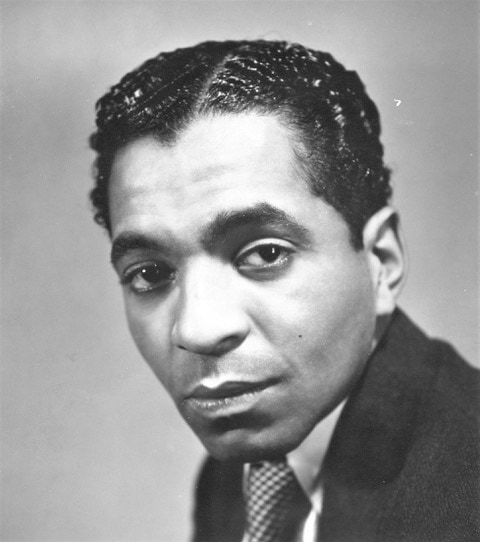
Hemsley Winfield in 1933. This Yonkers native and African American dancer, choreographer and director founded the groundbreaking Negro Art Theater Dance Group.
By Mary Hoar, City of Yonkers Historian, President Emerita Yonkers Historical Society, recipient of the 2004 Key to History, Member of the Yonkers Landmarks Preservation Board, and President Untermyer Performing Arts Council
Monday, January 15th
1934: Modern dance pioneer Hemsley Winfield of Wolfe Street passed away from pneumonia at the age of 26. The first African American under contract to The Metropolitan Opera, he performed the role of the Congo Witch Doctor in the premiere run of The Emperor Jones in 1933. He founded the New Negro Art Theater and was the first African American to appear on the concert dance stage. Winfield graduated from School Thirteen and Yonkers High School and studied at Columbia University before entering the world of dance and drama.
1940: City Manager Raymond Whitney, proving he could save nickels as well as dollars, ordered removal of all “special” water coolers in City Hall; at a monthly rental rate of $2.50 per cooler, this saved Yonkers $15 monthly. When asked why, Whitney stated, “City employees can drink City of Yonkers water.”
Tuesday, January 16th
1924: Civil War Veteran James Presise, one of Yonkers’ oldest residents, passed away at 91 in his Ashburton Avenue home. He moved to Yonkers in November 1861. Shortly after his move here, he joined the Union Army; he served throughout the war without injury. Hired by Eickemyer and Osterheld, he worked with electrical genius Charles Steinmetz. Persise also worked at the Tube Well Station on Saw Mill River Road, retiring at age 89 after working 34 years for the Water Board!
1940: City Comptroller James Hushion revealed the Suburban Bus Company, headed by former Alderman William Slater, had not paid one cent of the tax levied on all utilities since the tax was imposed in 1937.
Wednesday, January 17th
1945: Arthur Blair, President of Arthur G. Blair, Inc., announced the appointment of former Yonkers Fire Chief Edward Siller as Chief Fire Warden for the local shipyards company. Retired because of disabilities caused by injuries and burns, he received the Department Medal of Honor and other awards for heroism. Siller would oversee fire prevention and protect government and Blair properties at the Alexander Street and City Pier shipyards, site of the company’s defense work.
1952: Ninety-one former auxiliary police officers voted to ask for an official investigation of Yonkers Civil Defense leaders! The group resigned to protest suspension of their commander Charles Palmer; Auxiliary head Arthur Chambers suspended him on charges of insubordination because of a disagreement over uniforms. They selected nine men to present their request to the Common Council. When asked about the situation, Chambers denied anyone quit as no one submitted written letters of resignation to him.
Thursday, January 18th
1944: Yonkers school children collected newspapers, magazines and cardboard boxes to bring to their schools for the district wide paper drive. It took two pounds of this wastepaper to make the special V-boxes, special containers of fiberboard and paperboard used to send food and supplies to our fighting troops.
Unfortunately, one or more “unpatriotic, uncooperative” people attacked the carefully bundled piles of newspapers and magazines at five schools, opening and mutilating them.
1944: At the request of our local Post Office, local draft boards gave 60-day deferments to 38 Yonkers Postal workers; according to our Superintendent of Mails Charles Brady, any further reduction of staff would result in a sharp curtailment of services, and eliminate some deliveries.
Friday, January 19th
1942: NYC’s Greystone Press sent five hundred books to the Yonkers’ Victory Book Campaign! Two Yonkers residents headed the company, President Hans Teuenfils of Edgecliff Terrace and VP George Shively of Bronxville Road. At the time, book donations from Yonkers residents totaled upwards of 1100; more were left each day.
1945: After receiving phone calls from North Yonkers residents about a “skunk sitting on a fence” at 651 Palisade Avenue, SPCA Officer Frank Perna investigated. He greatly impressed those watching when he grabbed it by the tail and put it in a box to bring to a wooded section of Yonkers. Asked how he had been so calm while dealing with a skunk, he replied, “It was an opossum!”
Saturday, January 20th
1933: Public Safety Commissioner Denis Morrissey ordered every police officer begin compulsory training in target practice and firearms, regardless of what department they were in or their length of service. Lieutenant Jerome Linehan, Motorcycle Patrolman Herbert Schanck, and Patrolman Frank Yambra, previously an Army arms instructor, were the instructors. The order generated resentment, especially among those officers who hadn’t fired their service weapon in years.
1945: Twenty-four-year-old Captain Bernard Diekman, husband of Yonkers resident Leilah Diekman and pilot of a B-25 Mitchell bomber out of Corsica, received his first Bronze cluster on his Distinguished Flying Cross for “extraordinary achievement in an attack upon enemy supply and troop concentration near Santa Lucia, Italy.” Captain Diekman led a formation of twelve bombers over the target and inflicted “severe damage.”
Sunday, January 21st:
January 21, 1921: Yonkers tennis star Vincent Richards’ name appeared at the top of the United States Lawn Tennis Association National Junior Ranking list; Bill Tilden and Paul Gibbons were the selection committee.
1942: General Douglas MacArthur awarded Yonkers native Thomas Trapnell the Distinguished Service Cross for singlehandedly fending off a Japanese advance. On December 22, 1941, he remained between enemy troops and his men and set fire to a truck to block a bridge; under constant enemy fire, he waited until the bridge was fully engulfed in flames before leaving. Captured in 1942, he endured horrendous conditions during his imprisonment. When finally liberated from a Manchurian POW Camp by Russian soldiers, the former All America halfback, nicknamed the “warhorse of the West Point backfield,” weighed under 100 pounds when he was released.
Questions or comments on this column? Email YonkersHistory1646@gmail.com. For information on the Yonkers Historical Society, Sherwood House and upcoming events, please visit our website www.yonkershistoricalsociety.org, call 914-961-8940 or email info@yonkershistoricalsociety.org.





